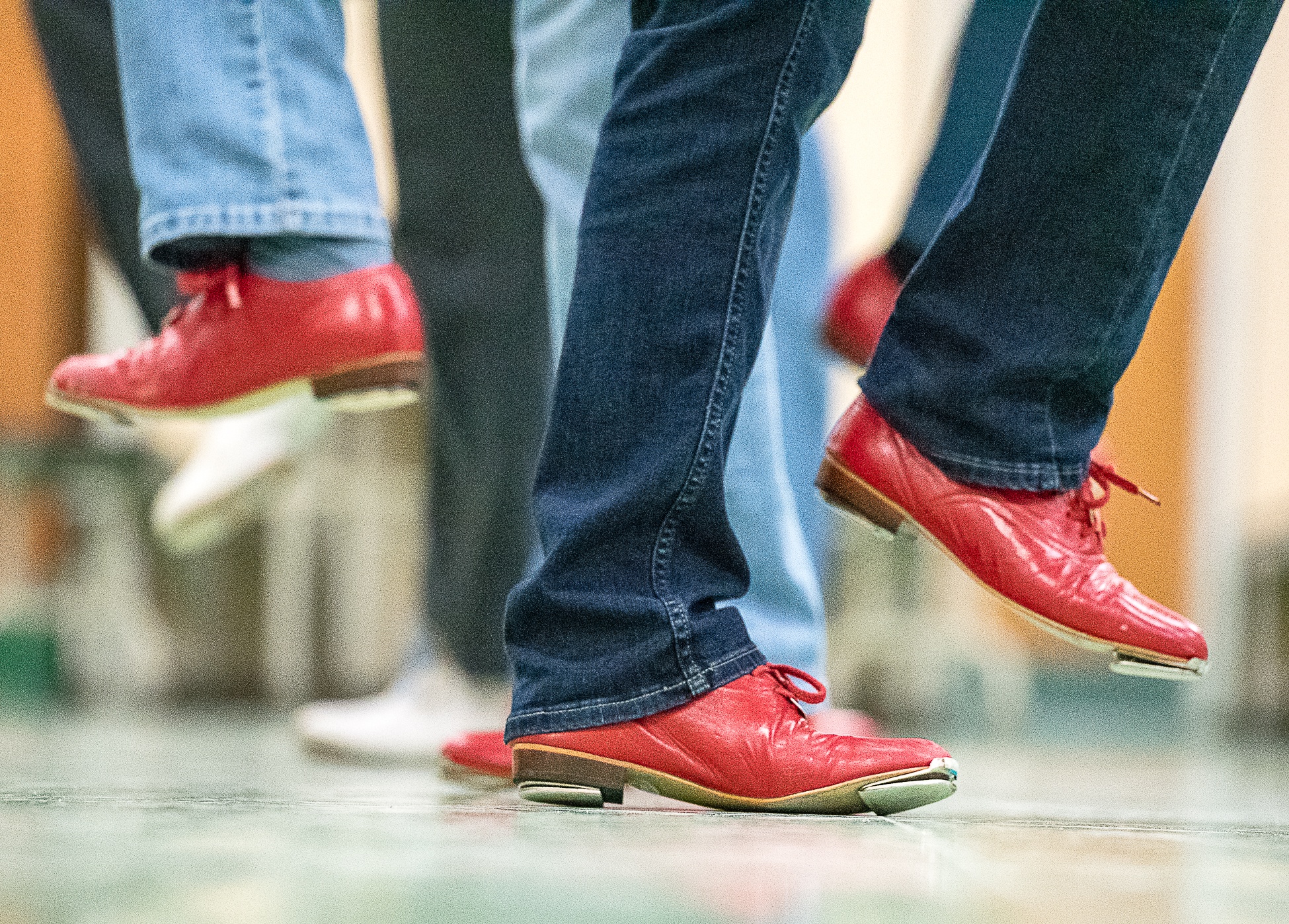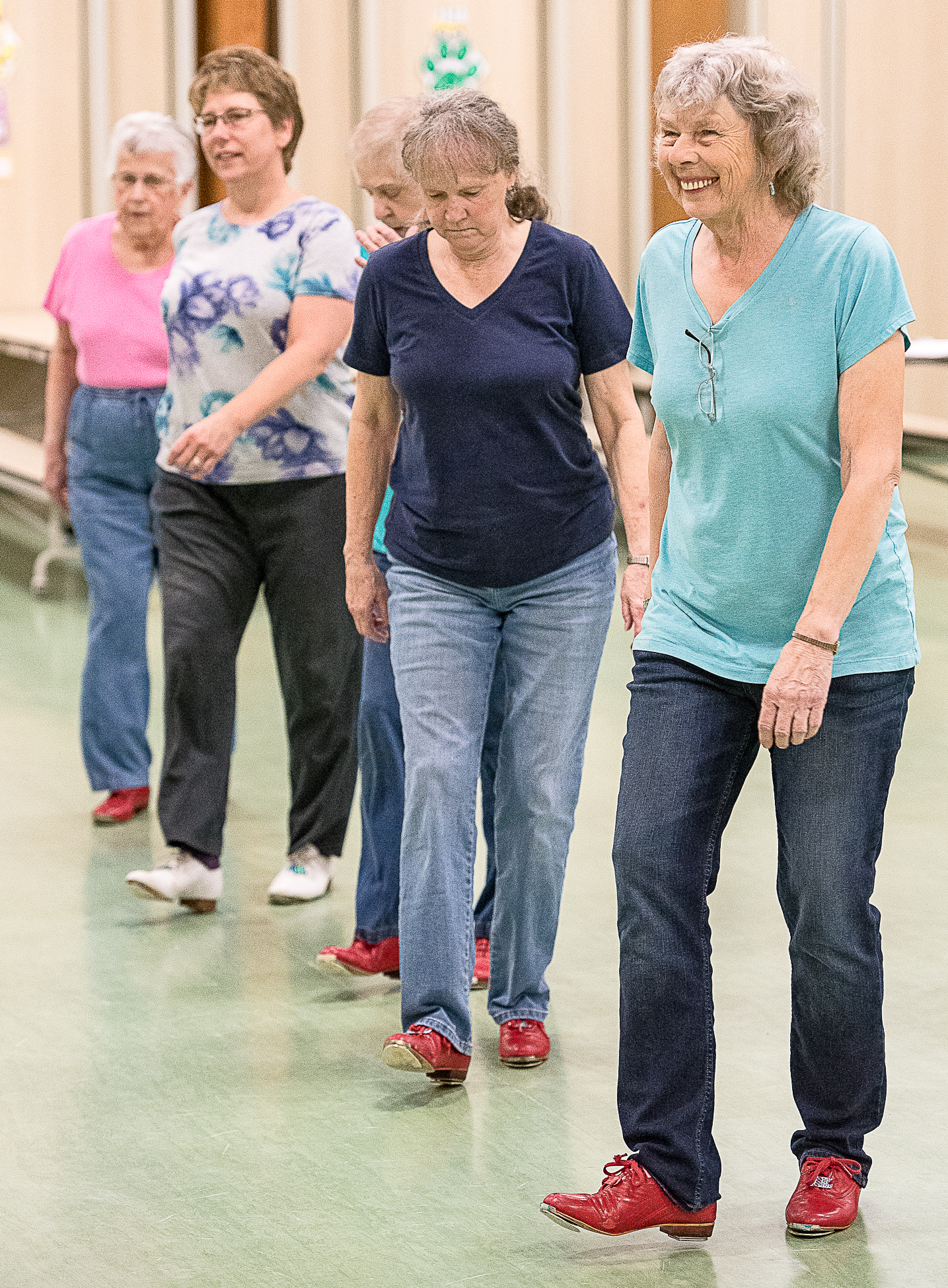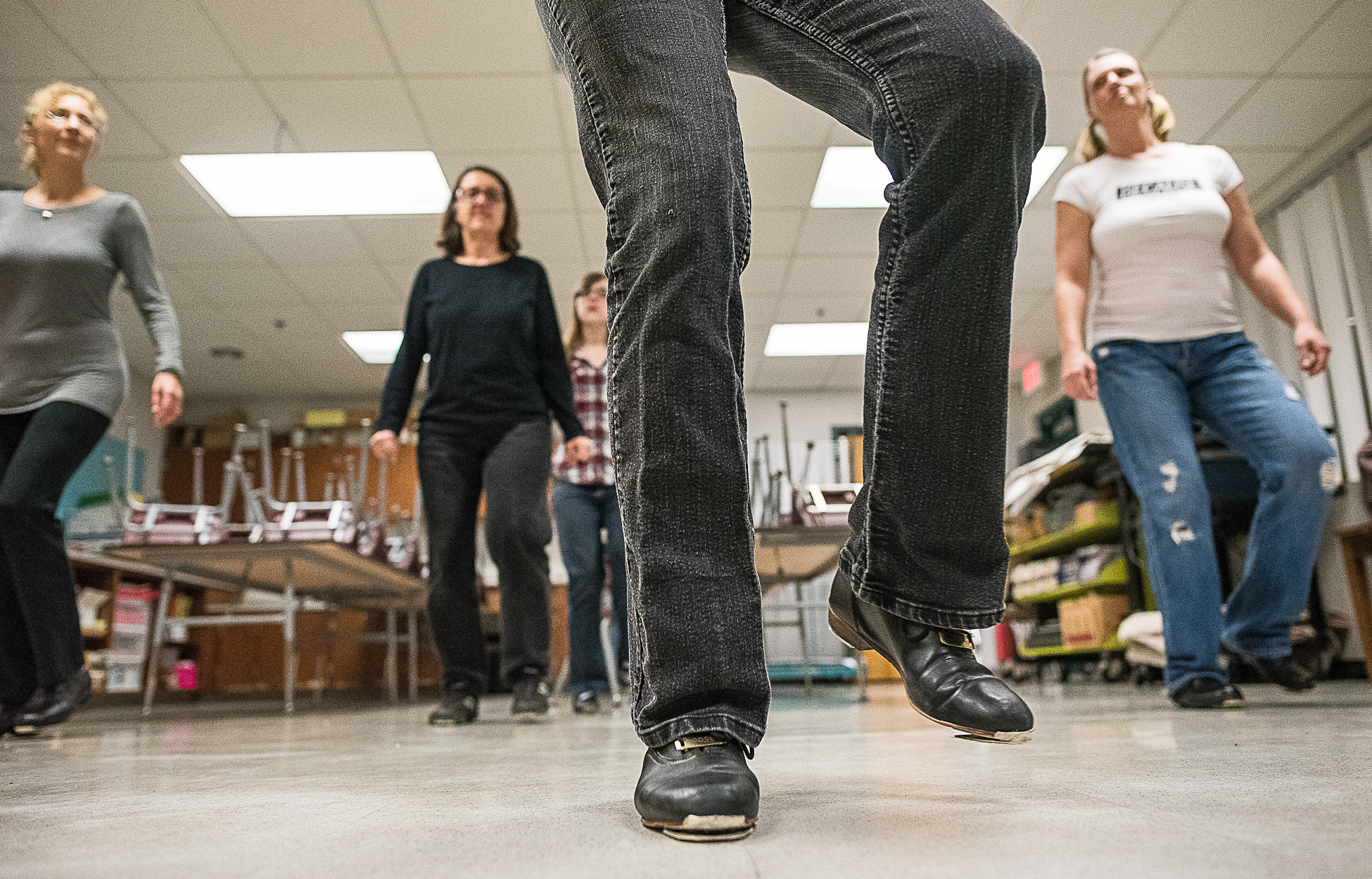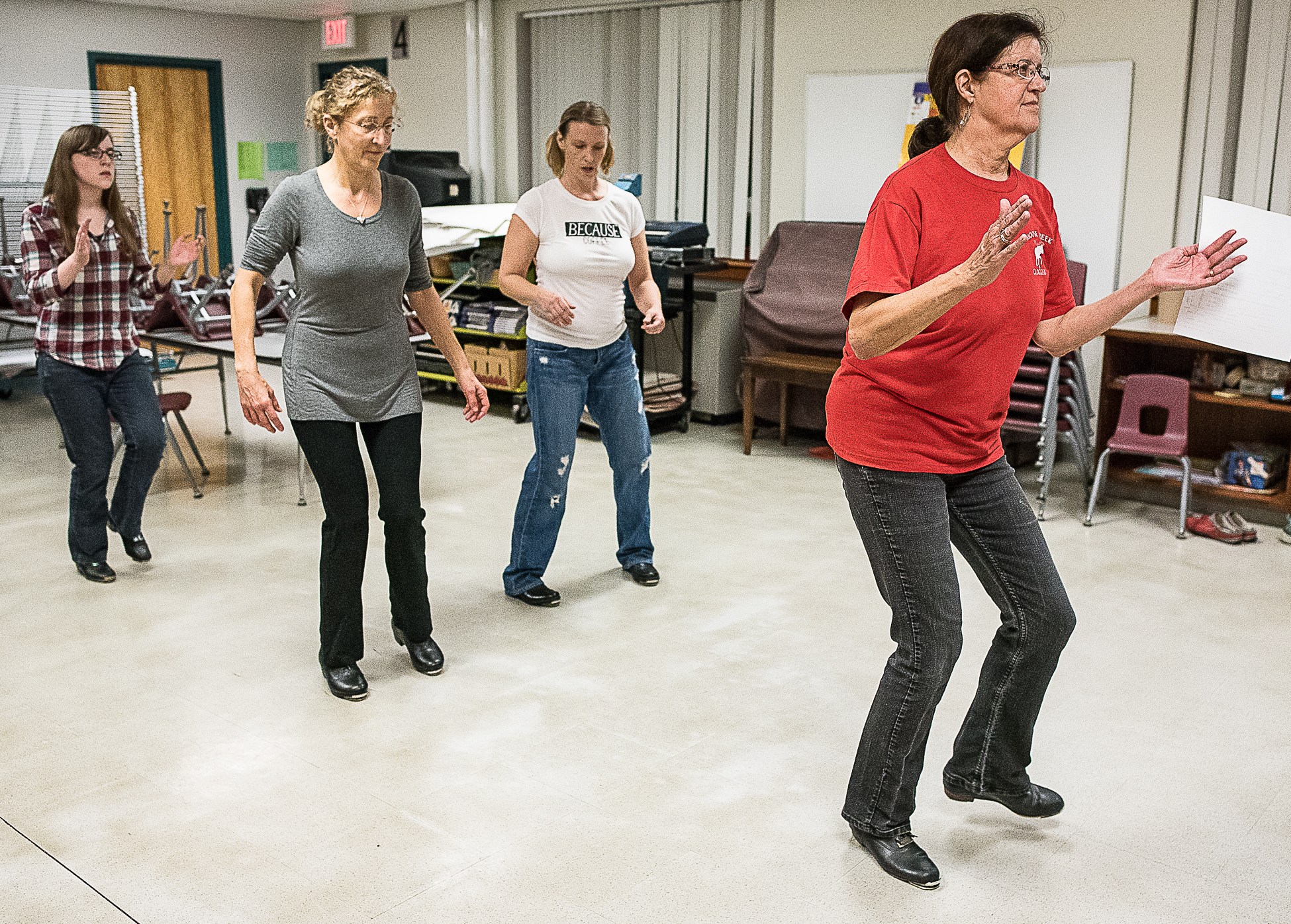
Moose Creek Cloggers wear specialized shoes with a “double tap” on the shoe. (Andree Kehn/Sun Journal)
‘They’re amazing’: Wilton dance group members range from 16 to 80 years old and are always stepping out for another show.
Immediately after finishing her weekly clogging lesson, Kelly Adams crossed the hall to the school gymnasium to watch the pros at work.
“The way they remember every step in every song,” the 42-year-old Canton woman said with unmasked awe. “I don’t know how they do it. They’re amazing.”
That seems like a perfectly valid assessment of the group known as the Moose Creek Cloggers, a team of dancers that performs at area nursing homes, county fairs, grange halls and various festivals across the state.
Amazing? I’d agree with that. The Moose Creek Cloggers features dancers as young as 16 and as old as 80. And frankly, where stamina and endurance is concerned, it’s near impossible to distinguish the teen from the octogenarian.
Consider Pat Libby, an 80-year-old who has been clogging for more than three decades. Watching her practice at the Gerald D. Cushing School in Wilton, I noted that she started the night with a cane in hand.
“I’ve got a bad knee,” she said, “and a bad hip. I’m just playing it cool with the cane so I’ll be ready when it’s show time.”
Sure enough, five minutes into practice, Libby had flung the cane aside and, alongside her dance mates, she was all flying feet and pumping arms and clicking shoes. She looked every bit as spry and agile as Kya Ruprecht, the 16-year-old in question.
Stamina? Endurance? Enthusiasm? Not a problem here.
“They’ll dance for four songs in a row,” says Gerald Libby, also 80 and Pat’s husband, “and then they’ll stand around chatting with each other like it was nothing.”
It’s true, you know. When they play the blueberry festivals, the ladies of the Moose Creek Cloggers will dance 15 songs in a row. At the nursing homes, they take it a little bit easier – just eight songs, with little to no pause between.
“A lot of the songs, we do them just to raise hell,” says 74-year-old Gloria Norton, who’s been rocking the clogs for 20 years. “And the people really enjoy it.”
What’s not to enjoy? You’ve got the dazzling choreography of people who have been dancing together for decades, you’ve got the driving beats of songs with titles like “Dance of the Old Swamp Rat” and you’ve got the rat-a-tat-tat clamor of the taps worn on the bottom of the shoes.
So, what is clogging? I had that question, too. The official definition goes like this: Clogging is a type of folk dance in which the dancer’s footwear is used percussively by striking the heel, the toe, or both against a floor or each other to create audible rhythms, usually to the downbeat with the heel keeping the rhythm.
Clogging is made up of basic movements – stomp, heel, brush, rock, etc. Those movements are then grouped together into two-, four-, and eight-count steps.
“It’s fun,” says Moose Creek dancer Karen Ruprecht, who also teaches a weekly beginners class, “and you don’t need a partner. You don’t need to rely on somebody else.”
The fact is, this team of pro cloggers make it look fun when they’re out performing. The upbeat music helps, as does the almost hypnotic clacking of the taps.
“Everyone that we dance for, they just love it,” says Naomi Henderson, a 67-year-old who has been clogging since the early ’90s. “At the nursing homes, they’ll be tapping their feet and smiling. You can just tell that they’re having a good time.”
I’LL JUST STAND OVER HERE
The other fact is that clogging isn’t easy. I know this because I tried, for about 10 minutes, to perform just a few of the basic steps in Ruprecht’s beginners class.
“It’s like you’ve got gum on the end of your shoe,” Ruprecht said, trying to teach me a basic lick, “and you want to get it off.”
Then she started rattling off more complicated steps for the group – Half Samantha, Fancy Double, Side Step, Rocking Chair, Fancy Triple, Full Samantha, the Outhouse – and I was out.
Gerald Libby, who provides the music for the group, has my back on this one – although they say clogging is for everyone, it is definitely dominated by the ladies.
“There are guys who dance,” Gerald said. “I’m just not one of them. Couldn’t do it. I don’t have the coordination or the wind.”
He may not be able to dance with the ladies, but Gerald has his roles. He provides the music, for one thing – cassette tapes were all the rage when he started, but now he’s rocking digital music through Winamp.
He’s also a lifeguard of sorts – in the summertime, when the cloggers are performing in 95-degree weather, Gerald has to occasionally remind the cloggers to take rests or to drink water. Once the ladies start tapping out their steps, they are on. The cloggers are in the zone, and that’s not just a trite expression.
“It’s fun and it’s good exercise,” says 55-year-old Michele Knapp, “but you can’t think of anything else while you’re doing it. You’ve got to focus on the steps. You have to concentrate on the choreography. It gets your mind off all the worries of the world.”
The meditative aspect of clogging is something I hear about plenty from both veteran dancers and those in the beginners class.
“It’s good for the brain,” says 51-year-old Alice Engelhardt, a foster care worker who started taking Ruprecht’s beginners class in September. “You have to be fully present. You really need to focus and concentrate. That’s the cool part – you have to just forget everything else. It’s cathartic. You can’t over-think it. If you do, your body will become too stiff.”
“It’s fun,” says Zale Lochala, a New Sharon school teacher who’s also new to the clogging game. “But it’s not easy. It’s just following the steps – I know what I’m supposed to do, it’s just a matter of getting my legs to do it. It’s a lot of memorizing.”
Lochala falters a few times as Ruprecht leads the beginners through the steps. It’s frustrating, she admits. She’s not picking it up as quickly as she’d like to, but her motivation for sticking with it is beyond reproach.
“I’m a teacher,” she says. “I want my students to try their hardest, and I feel like I’m not doing what I’m asking my students to do. I try to think about that as I’m doing this.”
The Moose Creek Cloggers will dance to almost anything, whether it’s Appalachian hillbilly music, jaunty Christmas tunes or plain old rock ‘n’ roll.
“As long as it has a good beat,” says Pat Libby.
The Moose Creek Cloggers estimate they have at least 100 songs in their repertoire. A quick glance at the playlist reveals titles like “Chattanooga Shoe Shine Boy,” “Papa Joe’s Polka” and “Guitar Fiddlin’ Joe.”
The group performs twice a week, whether it’s for practice or at live performances. They danced recently at the Skowhegan Fair, at the blueberry festivals, at Odd Fellows & Rebekah’s Home in Auburn.
“We dance all over the place,” said 70-year-old Brenda Lachapelle, another 30-year member of the Moose Creek Cloggers.
While the pros were practicing and making it look easy at the Cushing School last Monday, a few students from Ruprecht’s beginners class watched them with admiration. Respect. Maybe a little envy.
“I’m definitely not ready for this group,” said Engelhardt. “Not yet.”
“I’m going to stick with it,” said Adams, munching on raisins and watching the dancers. “I’ve always wanted to be a clogger, I just didn’t know how to go about it.”
Just pretend there’s gum on the end of your shoe and try to kick it off, that’s the ticket. How hard can it be?
Me, I’ll be sitting quietly with Gerald. We may not be able to clog a lick, but at least we’re wise enough to have learned that lesson quickly.

Naomi Henderson, far right, sets the pace for the Moose Creek Cloggers on Monday night in Wilton. Pictured from left are Pat Libby, Michele Phelps, Gloria Norton and Brenda Lachapelle. (Andree Kehn/Sun Journal)
A brief history of clogging
Clogging, known as the “melting pot of dances,” began during the 1700s in the Appalachian mountains of the eastern United States. Scottish, Irish, English and Dutch-German settlers found common ground through dance. Over time, their styles wove together and clogging was born. As clogging spread throughout the United States, other influences, such as Native American and African, found their way into the dance form.
Traditional clogging, also known as “drag-style clogging,” is a percussive dance where a dancer produces rhythmic sounds using steel double taps positioned on the heel and toe of the shoe. The sound then combines with the rhythm of the music, which was traditionally bluegrass. Many times mountain figures, or square dance figures, are combined with freestyle clogging footwork to form hoedowns.
Source: DanceAdvantage.net

Students of the beginner clogging class follow along with the instructor, Karen Ruprecht, front and center, on Monday at the Cushing School in Wilton. From left are Alice Engelhardt, Zale Lochala, Kya Ruprecht and Kelly Adams. (Andree Kehn/Sun Journal)
Ready to clog?
You want in? The Moose Creek Cloggers are part of the Regional School Unit 9 Adult Education Program. For more information about classes or performances, email Pat Libby at [email protected].

Karen Ruprecht, far right, leads a beginner clogging class at the Cushing School in Wilton on Monday evening. Following along, from left to right, are her daughter, Kya Ruprecht, Alice Engelhardt and Kelly Adams. (Andree Kehn/Sun Journal)
Work the steps
Some of my favorite clogging steps – not that I can do any of them, mind you, I just like the sound of them – are: Shave and a Haircut, Kentucky Drag, Pothole, Mountain Goat, High Horse and Rocking Chair.
Comments are no longer available on this story